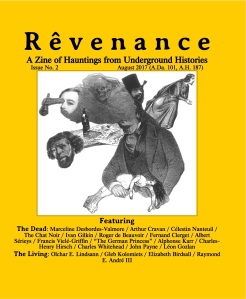Rêvenance: A Zine of Hauntings from Underground Histories. Issue 2.
–ed. Olchar E. Lindsann

Rêvenance is the flagship journal of the Resurrecting the Bouzingo project and Revenant Editions series, dedicated to the forgotten or untold histories of 19th Century avant-garde and other countercultures. It includes essays, translations, and many experimental forms of historical writing and research that connect those traditions to continuing radical communities today.
This issue includes an 1832 satire of the Bouzingo translated by Elizabeth Birdsall, essays on experimental historiography by Olchar E. Lindsann and Gleb Kolomiets, poems by Arthur Cravan, Marceline Debordes-Valmore, Ivan Gilkin, and Francis Vielé-Griffin (the latter from a manuscript previously unpublished even in French), the preface to Roger de Beauvoir’s 1840 book about the 18th Century black musician and revolutionary soldier the Chevalier de Saint-Georges, a biography of a 17th Century female scam artist known as The German Princess, a 1912 review of Arthur Cravan’s proto-Dada journal Maintenant, transductions by O. Lindsann of poems from the Chat Noir group, and images by Célestin Nanteuil.
Featuring: Olchar E. Lindsann, Gleb Kolomiets, Elizabeth Birdsall, Raymond E. André III, Marceline Desbordes-Valmore, Arthur Cravan, Célestin Nanteuil, The Chat Noir, Ivan Gilkin, Roger de Beauvoir, Fernand Clerget, Albert Sérieys, Francis Vielé-Griffin, “The German Princess”, Alphonse Karr, Charles-Henry Hirsch, Charles Whitehead, John Payne, & Léon Gozlan.

36 pgs on folded 8.5”x14”. Sept., A.Da. 100 (2016).
$5.50 + 1.00 s/h or FREE DOWNLOAD
–ed. Olchar E. Lindsann

Rêvenance is the flagship journal of the Resurrecting the Bouzingo project and Revenant Editions series, dedicated to the forgotten or untold histories of 19th Century avant-garde and other countercultures. It includes essays, translations, and many experimental forms of historical writing and research that connect those traditions to continuing radical communities today.
This issue includes an 1832 satire of the Bouzingo translated by Elizabeth Birdsall, essays on experimental historiography by Olchar E. Lindsann and Gleb Kolomiets, poems by Arthur Cravan, Marceline Debordes-Valmore, Ivan Gilkin, and Francis Vielé-Griffin (the latter from a manuscript previously unpublished even in French), the preface to Roger de Beauvoir’s 1840 book about the 18th Century black musician and revolutionary soldier the Chevalier de Saint-Georges, a biography of a 17th Century female scam artist known as The German Princess, a 1912 review of Arthur Cravan’s proto-Dada journal Maintenant, transductions by O. Lindsann of poems from the Chat Noir group, and images by Célestin Nanteuil.
Featuring: Olchar E. Lindsann, Gleb Kolomiets, Elizabeth Birdsall, Raymond E. André III, Marceline Desbordes-Valmore, Arthur Cravan, Célestin Nanteuil, The Chat Noir, Ivan Gilkin, Roger de Beauvoir, Fernand Clerget, Albert Sérieys, Francis Vielé-Griffin, “The German Princess”, Alphonse Karr, Charles-Henry Hirsch, Charles Whitehead, John Payne, & Léon Gozlan.

36 pgs on folded 8.5”x14”. Sept., A.Da. 100 (2016).
$5.50 + 1.00 s/h or FREE DOWNLOAD



